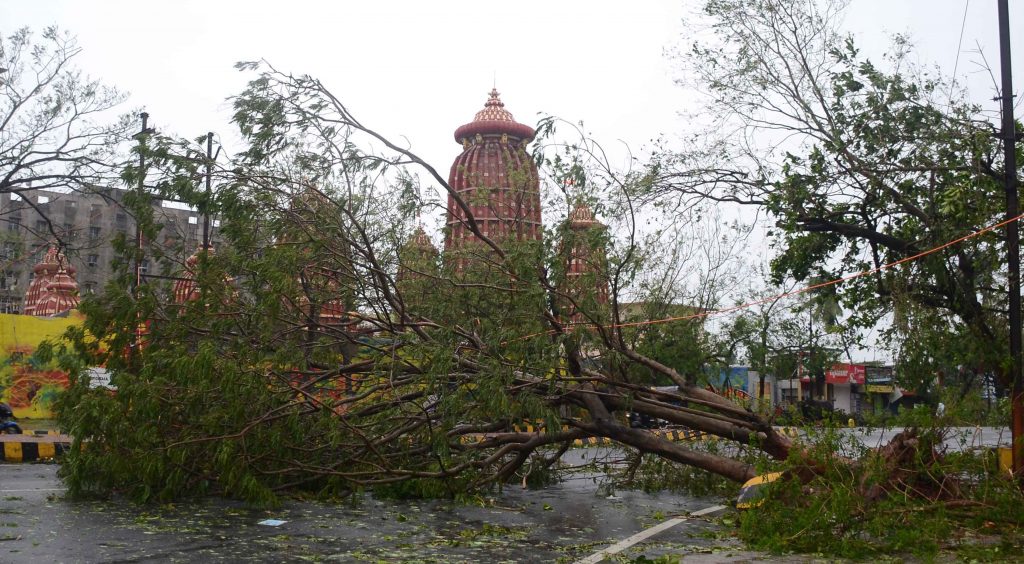Bhubaneswar: This day last year had seen the very severe cyclonic storm Fani having pulverised several parts of the state to smithereens. The state capital Bhubaneswar and the pilgrim town Puri were hit so badly that the footprints of the cyclone are still extant—leaving a telling impact on the cities’ landscapes and their skylines. Odisha, long used to natural disasters, some even more severe than Fani like the 1999 Super Cyclone, may not forget the severity of Fani for generations.
It is paradoxical to note that while the state had battled with Fani May 3, 2019, this time around the worldwide coronavirus has forced people to lapse into their cocoons.
It was really a scary Friday, to say the least, when 200-km-per-hour strong wind hit the landmass of Odisha in May last year. Very severe cyclonic storm ‘Fani’ was the strongest and first-ever tropical storm in last 43 years that made landfall at Balukhand wildlife sanctuary in Puri.
Massive destruction was created by the first spell of wind accompanied by heavy rain.
However, the devastation was beyond measure when the second phase of the storm hit the landmass after a brief lull. Roofs of thatched houses and asbestos sheets were gone with the gusty wind while many trees and utility poles were uprooted, blocking the roads.
While the situation in Puri was horrifying, it was no less in Bhubaneswar. People were heard saying Fani was more severe than 1999 Super Cyclone. This could be gauged from the fact that around 1.56 lakh electricity poles were either damaged or uprooted in the Capital city alone.
The casualties, unlike the Super Cyclone, were reduced by timely action and evacuation by the government. The state government and OSDMA evacuated over 1.2 million residents from vulnerable areas and moved them to safer places and into cyclone shelters.
Lives in Bhubaneswar and Puri were turned upside down. There was a total breakdown of power and telecommunication networks.
It took more than a month for installation of mobile towers and DTH antennas. People made long queues for drinking water and even food at distribution centres. It took from a week to a month’s time to fully restore power in the Capital city.
Puri denizens had a harrowing time with a month-long blackout. With no power and water, people felt like the situation had gone back to the 60s. Exodus of people from the Capital city was also witnessed within a few days of Fani due to shortage of water, food and other basic amenities.
Long lines were seen before water kiosks and ATMs. Basic amenities eluded citizens. Angry survivors had taken to the streets to protest the slow pace of restoration and high prices of essential food items.
The state government had to hire additional staff from outside for speedy restoration of power.
Pilgrim City worst hit
The Holy city was worst hit as the tropical storm made landfall near Balukhand sanctuary. Sources said thousands of kuccha houses at Penthakata, Baliapanda and Ramchandi slums were destroyed by the winds and heavy rains. Almost all the roads in the Pilgrim city were blocked with uprooted trees and broken branches.
At least five-ft high waves lashed the beach during the storm. Vehicular traffic came to a grinding halt on Bhubaneswar-Puri, Puri-Konark and Puri-Satpada national highways due to uprooting of large trees.
An elderly woman died when a wall collapsed at Devighat Bhoi slum. Severe water-logging was also reported from Badadanda, VIP Road, Reserve Ground, State Bank Square and Belabhumi Marg in the city.
Power and telecom services were disrupted in the Holy City and other parts of Puri district. The Singhadwar was damaged under the impact of gusty surface winds. The idol of Jay at Jay-Vijay gate of Srimandir also bore the brunt of the cyclone. However, the flag (Neelachakra) atop the temple was unhurt. Heritage village Raghurajpur was also hit.
At least 64 killed
A whopping Rs 24,276 crore damage was caused to the state, as per an assessment report released by Chief Minister Naveen Patnaik in August, 2019.
As per official sources, the cyclone-affected more than 1.65 crore people in 18,168 villages and 52 urban areas spread over 14 districts and rendered over five lakh families homeless. The 14 affected districts were Angul, Balasore, Bhadrak, Cuttack, Dhenkanal, Ganjam, Jagatsinghpur, Jajpur, Kendrapara, Keonjhar, Khurda, Mayurbhanj, Nayagarh and Puri.
Of all, Puri, Cuttack, Kendrapara and Jagatsinghpur had been severely affected. Of the 241 injured, 160 belong to Puri district alone, followed by Jajpur where 74 people were injured.
As per the Union Home Ministry’s report, the casualty due to Fani stood at 64 while 5.56 lakh houses were damaged.
Likewise, 6,281 cattle were lost, 1,48,663 hectare of cropland affected and 6,416 boats and 8,828 nets were damaged.
Prime Minister Narendra Modi, during his visit to the cyclone-affected areas May 6, had announced Rs 2 lakh ex-gratia each for the families of the deceased and Rs 50,000 each for the injured.
PNN
